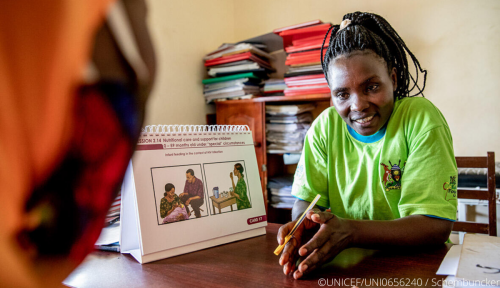
 The Global Social Service Workforce Alliance’s recent technical report, Social Service Workers in Health Facilities: Their Role in Addressing Social and Other Determinants of Health Among Children and Families, finds that with a social service workforce working in and linked to health facilities, there is much more potential for health systems to not only address clinical needs effectively and efficiently, but to tackle the inequities present in health care provision itself. Integrating social service workers in health facilities also allows countries to work towards more just, people-centered health systems and universal health coverage, in line with Sustainable Development Goal 3.
The Global Social Service Workforce Alliance’s recent technical report, Social Service Workers in Health Facilities: Their Role in Addressing Social and Other Determinants of Health Among Children and Families, finds that with a social service workforce working in and linked to health facilities, there is much more potential for health systems to not only address clinical needs effectively and efficiently, but to tackle the inequities present in health care provision itself. Integrating social service workers in health facilities also allows countries to work towards more just, people-centered health systems and universal health coverage, in line with Sustainable Development Goal 3.
Five cross-cutting advantages or benefits of having social service workers deployed in health facilities include:
- Enabling a holistic approach to health care: The involvement of the social service workforce in health facilities can expand the traditional medical model, which focuses on diagnosing and treating disease with medical interventions, with a recognition of and support for the social and other factors that enable more effective and lasting treatment. Incorporating this “social work” lens can result in fewer periods of ill health and increased access to advice and support to make changes in certain at-risk populations’ behaviour, social situation and environment, resulting in reduced hospital readmission rates, reduced length of patient stays in hospital, and reduced costs for health providers and/or patients.
- Addressing the social determinants of health: A significant proportion of the underlying factors contributing to poor health are social and behavioural, as much as physiological. In identifying, preventing and ameliorating these factors—including poverty, social exclusion, poor nutrition and housing, hazardous living conditions, abuse and violence—the social service workforce can play a key role in preventing or reducing illness and a range of health conditions. The preventive role can involve primary prevention (preventing initial onset of health conditions in the whole population) as well as secondary prevention (preventing or reducing ill health amongst the most at-risk populations or preventing its recurrence).
- Coordinating integrated care and support by working across sectors and disciplines: The social service workforce is trained and ideally placed to assess, plan, and coordinate complex packages of care and support. This care may involve input from medical practitioners and therapists, the support of community volunteers and civil society groups, and coordination with local social welfare departments, early childhood services and schools, labour services, housing departments and police.
- Early identification and coordinated intervention in cases of violence against children, women or elders: Deployment in health settings can enable social workers with statutory child protection roles, as well as those involved in the assessment and intervention in cases of intimate partner violence, sexual violence and elder abuse, an opportunity for early identification of risk factors and signs of abuse as presented in injuries, behaviour or concerns expressed by patients or their family member on admission to hospital or when arriving for emergency treatment. Once risks and concerns are identified, social workers in health settings are well placed to carry out multi-disciplinary assessment, and lead coordination with police and other statutory colleagues in child protection agencies, in the process of holding multidisciplinary case conferences, planning joint interventions and carrying out multi-agency reviews of such cases.
- Supporting patients across the life course: Since the role of social workers, supported by the wider social service workforce, is to help support people through all the major challenges and transitions they face in life, their deployment alongside health colleagues enables them to provide timely and tailored support to patients, to help them navigate these life challenges and transitions. Prominent examples include supporting older people to return home through organising the care and support they need following a fall or stroke and supporting the most vulnerable mothers and their infants—including adolescents, those without the support of a partner or family, or those experiencing intimate partner violence—through pregnancy, childbirth and early childhood.
Read more about the important role of social service workers in health facilities and how they can most effectively be deployed in the the full technical report: Social Service Workers in Health Facilities: Their Role in Addressing Social and Other Determinants of Health Among Children and Families.
